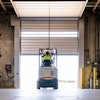Technology has improved over time to ensure that most winches, hoists, and cranes serve their purpose safely. However, advanced equipment technology isn’t the complete solution, and this critical area of material handling still requires some user know-how when it comes to accurate selection and maintenance.
When it comes to lifting product, a manufacturing environment can be home to the heaviest of loads. Fortunately for plant personnel, technology has improved over time to ensure that most winches, hoists, and cranes serve their purpose safely. However, advanced equipment technology isn’t the complete solution, and this critical area of material handling still requires some user know-how when it comes to accurate selection and maintenance.
Indianapolis, IN-based My-te Products, Inc. has been producing winch-hoists since 1957, with a footprint in various industries including manufacturing, construction, utility, marine, and more. According to company president, Brian King, the needs of My-te’s customer base have changed over the years as users focus more on safety, but also on performance requirements. “There seems to be a greater concern for safety features provided on the hoist,” he explains, citing that users these days typically want more control over the speed of the hoist. Besides safety and control, the energy efficiency goals of today’s manufacturers factor in to their necessary requirements. “Our equipment is frequently used in construction and in outside plant applications, and there’s a much greater awareness of the amount of power required to properly operate the machine. “
The requirements necessary, he adds, relate directly to application and usage considerations. Manufacturers attempting to select the proper hoist for their environment should be prepared to describe the basic information on what kinds of loads they’re working with. This includes elements like load speed, load travel, load weight, and – just as important – the available power source. In addition, explains King, users may be asked some or all of the following questions by their vendor:
- What is the ambient environment the machine will be operated in?
- Is it hot, cold, dusty, or explosive?
- Is it indoors, outdoors, or in a marine environment?
- Is it accessible for regular maintenance
or repair? - What’s the duty cycle?
- How will it be mounted and rigged?
- Will loads be lifted or lowered or both?
- Will the noise level of the operating machine be important?
- Will it be run by an operator or connected to a PLC or computer operated control system?
It may seem simple, but ultimately, says King: “The more information you can provide, the more likely you are to get a winch or hoist matched to your application.”
Once the hoist is in place, the process doesn’t end. With myriad potential maintenance concerns in play – as well as related safety issues – being familiar with the way the machine operates can result in the ability to pinpoint issues before they become costly or dangerous. “If something seems different, check it out,” he says. “Did it sound like that yesterday? “Also important for users is to check and record the condition of the wire rope before every shift, as well as establish a maintenance plan based on usage and follow it (For more pre-operational steps, see “A Daily Routine” on page 42). “Tighten the fasteners,” adds King, “and check the condition of electrical connections and components. Today’s industrial hoists have gear boxes built for a lifetime if they’re properly lubricated so don’t neglect regular lubrication checks.”
In the end, it’s often up to the user whether they get the right equipment for the job, and it stands up for the long haul. Simply put, says King, “Paying attention cannot be overemphasized.”






















